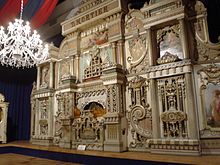- Dance organ
-
A dance organ is a mechanical organ designed to be used in a dance hall or ballroom. Being intended for use indoors, dance organs tend to be quieter than the similar fairground organ. Dance organs were principally used in Belgium and the southern Netherlands.
The dance organ came into its own during the 1920s, with large instruments built by Mortier and Gebroeders Decap Antwerpen (Dutch for Decap Brothers Antwerp). While the earlier instruments had classically carved wooden fronts, in the 1930s fashion dictated elaborate art deco appearances. Later still, during the 1950s, organs were built with a noticeably simpler appearance, often making use of formica and imitation wood coverings. More compact versions of the mechanical dance hall organ were also used in cafes and similar public venues as a form of early Jukebox, the folding perforated cardboard books would be connected together and held in a loop frame, a coin operated mechanism would bring the organ into play, supplying the latest music of the day.
Both firms Decap Herentals and Decap Antwerp had ingenious developments in dance organs which included use of the latest technology and instruments. Most popularly the use of a Hammond organ and other synthesis for creating sounds as well as the conventional pipework and other acoustic instruments. Subsequently both firms of the Decap family still make organs to this day, many new instruments have been built, including full traditional book operated pipe organs and smaller pipe / electric combinations, which make use of the popular range of Sound Modules by Roland and are operated by traditional 'book' music or MIDI technology. A super compact range of organs in the style of the Cafe organs were produced and are still built to order today, they are extremely popular and based on the Roland Sound Canvas, which gives an endless variety of sounds, but are programmed to recreate dance organ sounds as well as the sounds of a dance band. The accordions and percussions are operated pneumatically.
With rhythm being an important part of dance, dance organs usually have many more percussion instruments than other mechanical organs. The instruments will often have piano accordions mounted on the front, and these are connected to and played by the organ. The saxophones and trumpets that can be found on the front of dance organs are not actually played, but the keys will be operated to give the appearance that they are, when the rank of saxophone or trumpet pipes (or synthesizer) come into play.
Using advanced computer technology, Decap dance organs are still the ultimate music machine, some of the latest innovations include giving volume control to accordions, pipework and percussion by controlling air pressure and movement velocity. Recordings of vocal parts can also be synchronized to the music that is set to play for singing accompaniment.
Apart from Mortier, the principal builders of Dance Organs were Gebr. Decap and Arthur Bursens in Belgium, Gaudin and Marenghi in France. Other high quality Belgian instruments were built by Hooghuys in Geraardsbergen (Dutch for Grammont) and Brugge, after a long family history of building church-organs, reflected in the timbre and naming of the pipework. Arthur Bursens continued making pipe dance organs right into the 1970s. Bursens organs made under the Arburo name differed in being operated by paper rolls. This made for a much more compact arrangement. Most rolls played four tunes with a cut-off between each such that the patrons could operate the organ by a remote coin box in a similar way to the Decap cafe organs.
See also
Categories:- Organs (music)
- Mechanical musical instruments
Wikimedia Foundation. 2010.


